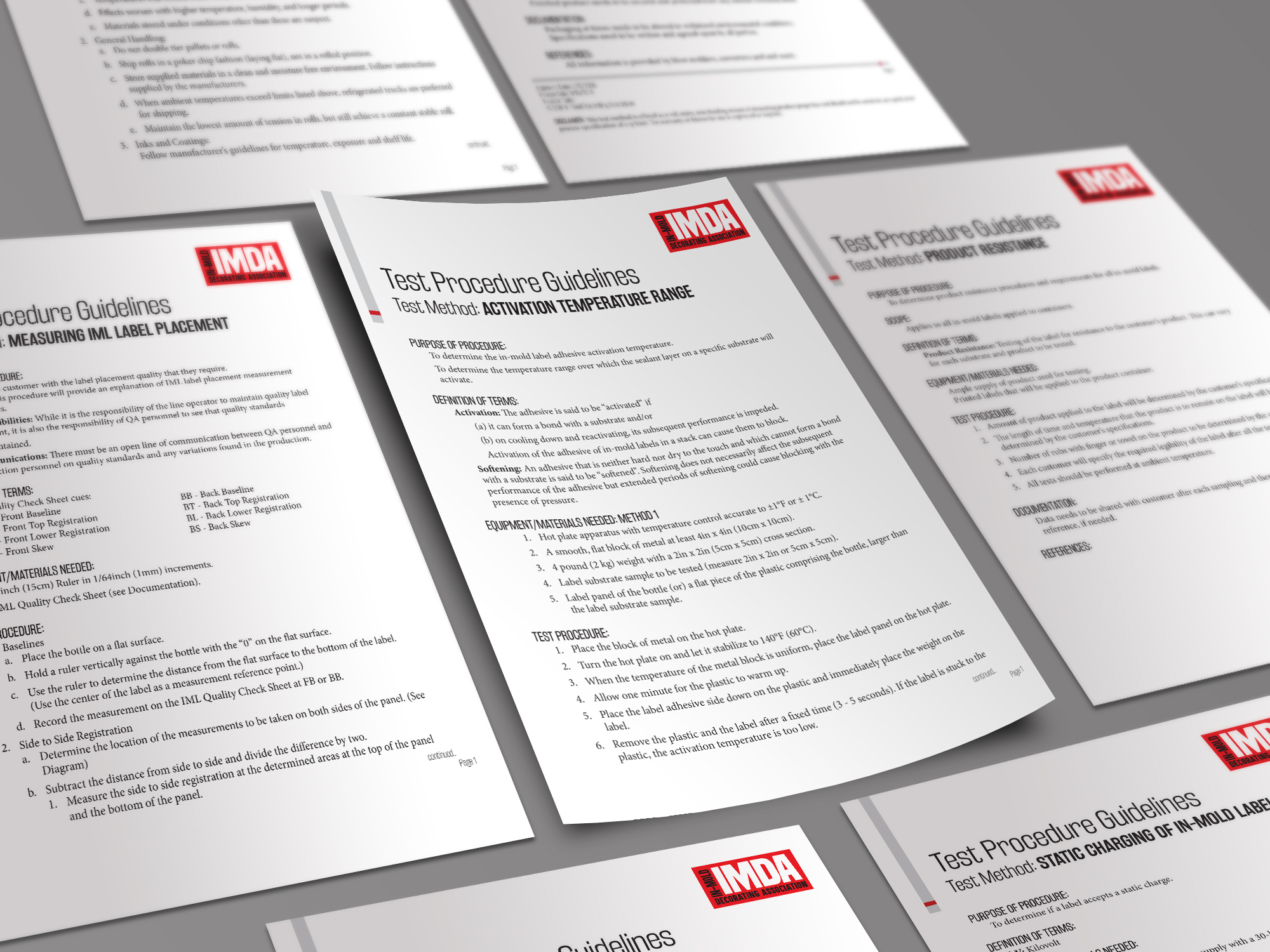TroubleShooting Guide
IMDA Member resources: production troubleshooting and testing guidance
These IMDA Members-Only Resources offer assistance and guidance. Additional technical guidance is in development at this time and slated for release in Fall 2023.

technical test guidelines
From adhesive uniformity and bottle wall thickness to label curl, scuff resistance and static testing, the IMDA provides Technical Test Guidelines that define the purpose of the procedure, testing steps and outcomes.
Troubleshooting tips
The Troubleshooting Tips below offer common solutions to challenges in IML and IMD. In addition, keep these in mind:
- Scrap rates can range from less than 1 to 5%.
- Gate locations can be directly behind or on the edge of the graphic.
- Most issues occur before entry into the mold.
- End-of-arm tooling can make or break a program.
- Static electricity is not a precise science.
Problem #1: Movement of Graphic Out of Position
Diagnosis: Look for skid marks or streaks in plastic around label.
Skid Marks: Pinning force is less than force of injection on edge of part.
Clean mold surface
& static pins.
Increase charge
(15-20 kv range).
Pin leading edge of graphic
(in-mold pinning).
Increase wanding time
(remote pinning).
Increase flow speed
(initial volume).
Reduce graphic thickness.
No Skid Marks: Robot, label magazine or end-of-arm tooling are out of tolerance.
Problem #2: Micro-Creases in Graphic
Knit Line Under the Graphic
- Move knit line.
- Increase graphic thickness.
- Locate pinner on crease area.
Multiple “Hard” Pinning Locations (in-mold pinning)
- Reduce number of pinning devices on EOA.
- Reduce static charge – allow for expansion.
- Move suction cups closer together.
- Locate pinner on crease area.
Compound Surface
- Locate pinner on crease area.
- Adjust graphic position or graphic size.
Problem #3: Overshots of Graphics – "Blowouts"
Multiple “Hard” Pinning Locations (in-mold pinning)
- Remove pinners.
- Reduce charge strength.
- Move pinner to blowout area.
High Mold Surface Temperature
- Reduce mold surface temperature.
- Change to higher distortion temperature material.
Multiple Gates
- Adjust the timing of gates.
- Reposition graphic closer to one of the gates.
Problem #4: Bubbles
Hydroscopic Material
-
- Change material to solid film
(non-moisture absorbing).
- Change material to solid film
Primer Failure (Sub-surface constructions)
- Reformulate primer for molding temperatures.
Incomplete Fusion
- Increase injection temperatures.
- Change graphic material.
Problem #5: Ghosting – white "halos" around label, usually on the edge farthest from injection point.
Potential Cause: Low melt point base film.
Change to clear material
Decrease molding temperature
- Chill mold surface.
- Reduce extruder barrel temperature.
Change material to higher melt point formulation
Problem #6: Doubles – multiple labels picked from magazines.
Static Electricity in Magazine
- Add ionized air and a delay in pick sequence.
- Add edge resistance (Velcro hook).
- Change suction cup position and height – uneven pick-up.
- Add motion to pick-up.
Primer or Clear Coat is Too Tacky
- Reformulate primer (subsurface printing).
- Reformulate clear varnish (surface printing).
- Slip sheet graphics.
Die Cutting Edge Welding
- Sharpen die cutting tool.
- Cut single sheets.
Problem #7: Ink Washout (subsurface printing)
High Heat
- Change ink formulation.
- Reduce molding temperatures.
- Move away from the gate.
Final Thoughts
More is not always better (static).
Leading-edge is critical (in-mold pinning).
Overall pinning is not always important.
Slower fill is not better.
Moisture can compound many problems.